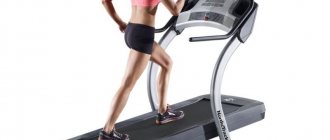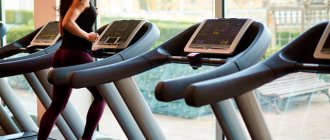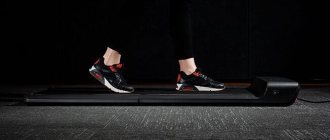>Workouts >Walking uphill on a treadmill: how to walk correctly
Cardio training strengthens the cardiovascular system, pumps up muscles and speeds up metabolism, stimulating the process of losing weight. One type of cardio exercise is walking uphill on a treadmill. The use of the simulator does not depend on weather conditions and is available both in fitness centers and at home.
The benefits of walking on a simulator
How can walking be useful?
- Maintaining good physical shape without excessive stress;
- Cardiovascular and respiratory system training;
- Regulation of load intensity. Ability to set various parameters: from small loads to quite significant ones;
- There are no age restrictions for classes. Indicated for keeping fit for older people;
- Gentle load on joints and ligaments;
- Possibility of using any free time.
- Perfect for pregnant women as a gentle physical activity.
8 rules for burning fat that you need to follow on the treadmill.
How many calories are burned when walking up the stairs?
It is known that you can quickly lose excess weight by climbing up. Moreover, to perform this exercise you do not need to look for a hill or mountain. So, going up to the 9th floor may well replace these natural objects. The amount of calories burned when walking up the stairs is 1300 kcal. Remember not to exercise immediately after eating. It is best to conduct classes in the morning. At this time, burning calories when walking up the stairs will be more effective. Do not forget about a short warm-up before the “ascent”.
How to walk correctly to lose weight?
Before you start training, you need to learn a few important rules, which will be discussed below.
How often should you exercise?
The walking program for burning fat is individual. On average it should be one hour a day. Some trainers advise exercising on this simulator every other day with intense exercise. You can use different types of activities, such as walking uphill and with weights, which involve different durations and different levels of intensity. How often and for how long should you exercise? To begin with, it is enough to exercise twice a week. Gradually, the load and frequency of exercises must be increased.
What heart rate and speed should it be?
Schemes for walking speed from different trainers may differ due to different approaches. One of the most common recommendations is to determine the speed by focusing on the pulse rate, which should be one hundred and thirty beats. Although this indicator is individual for everyone. Depending on the goals pursued during training, in sports circles it is customary to distinguish 5 pulse zones.
- The value of the maximum heart rate depends on age, health status, the presence or absence of physical fitness, as well as the presence of extra pounds.
- A trainer equipped with a cardio sensor will help you monitor your heart rate and adjust the load correctly.
- It is necessary to precede the workout with a warm-up, which is done by walking at a slow pace. The speed of walking must be gradually increased in order to reach the heart rate, which is on average one hundred and thirty beats. The speed should be such as to maintain this indicator for twenty minutes of walking.
- Then, at the final stage of training, the speed is gradually reduced . The recommended time for this stage of training should be ten percent of the time of the entire session.
- An indication that you have chosen too high a speed is that you feel very tired, so you need to adjust your speed downwards.
A detailed overview of the main functions and modes of treadmills can be found here.
Attention! It is necessary to change the speed after pressing the “stop” button and stopping the track. To comply with safety regulations, functions must not be changed while the machine is operating.
How to breathe during training?
Correct breathing is, first of all, measured breathing. If you are out of breath and lacking air, then the pace of walking is chosen incorrectly and its intensity must be reduced.
Treadmill training programs
If you think that treadmill training is limited to walking or jogging, you are sorely mistaken. Find out what variety of exercises and workouts this machine can give you.
There are many fitness methods for getting rid of extra pounds, but opinions agree on one thing: a treadmill for losing weight is the most effective means, of course, subject to a well-designed training program.
Benefits of a treadmill
Training on a treadmill has a healing effect on the entire body: your blood pressure is normalized, the functioning of the cardiovascular and respiratory systems improves, and bones are strengthened. This aerobic exercise, which is running, develops your endurance. You saturate the entire circulatory system with oxygen, increasing muscle tone. And all this in addition to the fat-burning effect. On average, calorie consumption on a treadmill is 600-700 kcal/hour. This number may vary depending on the intensity of your workout.
Researchers from King's College London have found that exercise that strengthens leg muscles can improve cognitive performance in older adults over the long term. In a study of 324 healthy twin sisters followed for 10 years, researchers found that leg exercise slowed the rate of brain aging, which was a protective factor against Alzheimer's disease.
How to run correctly
Running technique. While doing exercises on the treadmill, your shoulders and chest should be straightened and your abs tense. The arms are also included in the work: they are bent at the elbows at a right angle and act in the opposite direction, which increases blood flow. Move smoothly, gradually increasing the pace from slow to fast. Read more: running technique.
Breath. Breathe deeply through your nose.
Best time to train. The debate about whether it is healthier to run in the mornings or evenings has been raging for a long time. If you have time in the morning, start the day with a cold or contrast shower and a run on the treadmill. This will energize you for the long day and will rev up your metabolism to earn carbs for breakfast. An evening run will allow you to relieve stress and calm your mind, in addition to all the other effects of running. Whatever time you choose to exercise on the treadmill, it is definitely healthier than lying on the couch.
Heart rate zone for fat burning To calculate the effective heart rate zone for an adult, during exercise in which the muscles work and the fat burning process occurs, use a special formula:
“220 minus (number of years)” or “200 minus (years after 20 years)”
Once you've calculated your maximum heart rate for your age (if you're 40, it's 180 beats per minute), you can determine your effective zone. In this example, this is 65 - 85% of the maximum, that is, from 180x0.65 to 180x0.85 = 117-153. It is better for you not to cross the boundaries of this zone: if the pulse is higher, there is a risk of overload, if lower, the effect of training on the treadmill will be minimal. Remember your effective heart rate and try to stay within its limits during cardio. But be careful: If you're 40 and this is your first cardio workout since college football, choose a gentler regimen.
Duration of training Due to the physiological characteristics of the body, it is important that your training is long enough. You can exercise with a heart rate slightly below the effective zone, but in this case your training on the treadmill should be longer by 20-30 minutes, ideally from 40 minutes to 1 hour. The optimal amount of training on a treadmill is 3 times a week. If you exercise more often, the body simply will not have time to recover and such loads will not bring benefits. And a weight loss program consisting of 1-2 workouts per week is practically useless (unless you supplement it with strength training).
Treadmill exercises Walking
It has an almost miraculous effect. In addition to accelerating the fat burning process, walking can relieve tension while simultaneously working all muscles. A minimum of 30 minutes of vigorous walking a day, either outside or on a treadmill, will help you maintain cardiovascular and respiratory health.
Run
The benefits of running on a treadmill are literally legendary. This type of cardio is the most popular, and is truly addictive - in the good sense of the word. If the first runs may give you mixed feelings of reluctance and laziness, then over time running training will be a joy.
Sprint
Allows you to get the most out of your potential. This type of treadmill workout requires you to push yourself to the limit, but also burns calories at full capacity.
Inclined
This is the easiest way to make your workout more challenging. By changing the incline angle, you contribute to even faster weight loss during workouts on the treadmill. Today, a method based on alternating walking at an incline and walking at a certain speed is increasingly gaining popularity in the niche of cardio training. And for good reason: regular exercise of this type really allows you to get your figure into the desired shape in a short time.
Speed
The main enemy of training effectiveness is monotony. There is only one way to avoid tedious exercise - by turning your treadmill workout into a game of speed. By alternating between jogging and walking, or walking and running at top speed, you'll get more fun and better results from your treadmill workout.
Interval training on the treadmill
If you accept the rules of the speed game mentioned above and include alternating rest and acceleration in your workouts, you can lose weight many times faster. This type of training is called interval training, it is distinguished by the duration of the intervals: limited in time or lasting as long as you have the strength.
Clearly timed intervals in training on a treadmill can be different, for example, 1 minute of sprint, 2 minutes of recovery, or 4 minutes of intense running with an incline, rest - 7 minutes. Planning for such an interval cardio workout on a treadmill depends on your physical fitness and cardiovascular health.
Interval training on a treadmill that does not have clear intervals is called “fartlek”, from the Swedish fartlek - “speed game”. This type of training involves running at full strength until failure, to use bodybuilding terminology. Once your strength is gone, take a recovery break, walk, and then run again at top speed. The most important thing for weight loss in this type of training on the treadmill is to work at your limit during the speed segment. Give it your all, stopping only when you no longer have the strength.
Whichever treadmill interval training program you choose, you'll notice results soon: it's been proven that calories continue to be burned even after the workout ends. set of exercises on a treadmill
Treadmill workout
Choose your level
Beginners: You should be prepared to do aerobic training for at least 3 months. Spend at least 2-4 weeks on endurance training, and only then move on to interval training.
Continued: You are in this group if you have been doing aerobic exercise at least 3 times a week for 3 months or more.
Advanced: You can focus on the level of requirements for this group if you have been doing aerobic training 4-5 times a week for at least 6 months.
All workouts should begin with a warm-up - 5 minutes of low-intensity cardio exercises: leisurely jogging around the gym or exercises on cardio equipment. The same amount of time should be allocated to complete the workout for the cool down. Cardiac activity should be changed gradually, the most harmful thing for our heart is not only the rapid onset of intense long-term exercise, but also its abrupt cessation.
Choose an aerobic intensity level that allows you to maintain a steady heart rate throughout your workout.
The principle of training
Every two weeks for beginners and intermediates, you can either increase the intensity of your workout or increase your workout time by 5%.
Most importantly, do not increase the intensity and duration of your workout at the same time!
The proposed cardio training program on a treadmill is designed for 30 minutes and consists of a warm-up, a uniform load, buttock training and a tempo part.
Warm-up
- Duration – 5 minutes
- Running speed – 5-6.5 km/hour
- Slope – 0%
Start your workout at the lowest speed. After two minutes, increase the speed by 0.3 km/h every 30 seconds. Gradually increase your speed to 5.5 km/h.
From time to time you can rise on your toes, holding the handrails, then walk on your heels for a few seconds. This is necessary to prepare the lower leg for walking uphill.
Try to stretch your arms and upper torso as well.
Uniform load
- Duration – 10 minutes
- Speed – 6.5 km/h
- Slope – 1%
Gradually increase your speed by 0.3 km/h until you are running.
At this point, those who prefer walking should reduce their speed by 1 km/hour, and those who prefer running should increase their speed by 1 km/hour.
Drive at this operating speed for 5 minutes on a 1% incline.
Then increase the incline to 3%, and for 5 minutes, increase the incline by 1% every minute thereafter, up to a total of 8%.
Strengthening the buttocks
- Duration – 10 minutes
- Working speed
- Slope varies
Reduce the slope to 2%. Walk or run at a working speed for 1-2 minutes. After this, walk or run at maximum speed, and then for 1 minute reduce the speed by 1-2 km/h.
Repeat the intervals twice. Increase the incline to 12% and begin brisk walking at a steady speed for 3-4 minutes. Repeat intervals and moving uphill.
Tempo part
- Duration – 5 minutes
- Speed - working
- Slope – 2%
Reduce the incline to 2% and run or walk at your running speed for 4 minutes. Then reduce the incline to 0% and gradually slow down to lower your heart rate.
Don't forget a water bottle and a towel. Guide yourself - 50 ml every 10 minutes.
Goal: make your legs beautiful
Choose between hills and rough terrain programs on the track. In “hills,” ascents alternate with movement in a straight line (this task is more difficult), and in “rough terrain,” with descents. If you are not very hardy yet, it is better to choose this one. But just don’t try to alternate walking uphill with running in a straight line. This is an unfortunate option: an experienced athlete rests while running in a straight line, but for beginners, both running and walking uphill is a considerable load. In this case, it is better to reserve only one of the running sessions per week for “hills”.
It is better to line up the “hills” as follows (by slope in percentage): 1-3-1-5-1-7-1-5-1-3-1. Run at your average pace, uphill for 1 minute, straight for 40 seconds. Don't forget about the cool-down and warm-up: 7-10 minutes of easy running at the beginning and end of the workout.
Goal: develop speed qualities
After 5-7 minutes of easy warm-up running, begin to accelerate. “To learn to develop higher speed, do a 25-second jerk, trying to give your best,” advises Evgeniy. - Then go to a slow run or vigorous walk and recover for 2-3 minutes. Make another throw, rest again. Repeat two times or more. How much exactly - decide based on your well-being (as soon as you realize that you are too tired for the jerk, stop) and time - interval training should not be longer than 20-30 minutes.”
To develop speed endurance (after all, our task is not just to rush to the finish line, but also to reach it), accelerate to a heart rate of 80-90% of the maximum and try to maintain the pace for 40-50 seconds. Then rest for 3-5 minutes.
Goal: lose weight by 5 kg
The figure in this case is very arbitrary: in three months you can lose one or eight kilos, depending on your initial weight (very obese people lose weight faster), nutrition and the amount of training. The treadmill offers two paths to a slim figure.
- The first is long, 40-60 minutes, training at a moderate pace (heart rate - 60-70% of maximum). Light running or walking, which is more suitable for obese people, can be practiced at least daily or even twice a day. For the muscles, this is not such a serious load that a day of rest is required after it.
- The second way is interval training. The intervals here will be different than with speed training. Try starting with one-minute bursts of acceleration, alternating them with a three-minute rest - running at a moderate pace. The task can be gradually made more difficult by increasing speed intervals and reducing recovery time: first to a ratio of 1:1, then to 2:1. It's important not to overwork yourself. Since interval training can lead to overtraining, you need to alternate it with others and apply it: we give it our all for two or three weeks, then take a break.
Remember that diet is the main contributor to fat loss.
The effectiveness of these workouts for weight loss
With regular exercise, brisk walking or running is a fairly effective way not only to lose excess weight, but also to avoid gaining it in the future. By changing the incline of the treadmill and increasing the speed, you can tailor the workout to your needs.
The ideal combination is running on a treadmill along with a balanced diet. With this approach, you can lose up to one kilogram per week.
Nutritionists call this type of weight loss ideal, since calories are consumed slowly, which means the results are more stable than with rapid weight loss.
Instructors and sports doctors advise adhering to the principles of healthy eating at all times. By losing extra pounds through excessive consumption of high-calorie foods, you can gain them back again.
The most complete overview of all 6 types of treadmill activities can be found here.
Energy consumption when walking
Only a healthy and physically fit person can afford to actively engage in sports. Unlike strenuous, high-impact workouts, walking is less taxing on the body. Exercises help improve the functioning of the lungs and heart. Energy consumption when walking depends on the pace of movement and the athlete's metabolism. During a leisurely walk of 2-3 kilometers, up to 300 kilocalories are consumed. At a speed of 7 km/h you can burn up to 500 kcal. It is worth considering that without a properly selected diet, it will not be possible to achieve noticeable results.
How long is it recommended to walk each day?
Everyone has probably heard about 10 thousand steps a day to get rid of all diseases and problems? As in the case of 2 liters of water, this is a stereotype. And it comes from Japan, where the inventor of the first electronic pedometer, Yoshiro Hatano, called it Mampo-kei. Translated into Russian, this means “10,000 steps.” One version of why Yoshiro named his invention this way is that it’s just a beautiful round number.
10,000 steps is approximately 8 km. And many, of course, are frightened by this figure. There is no need to take it literally, because there are a lot of variables: what surface a person moves on, at what speed, in what weather conditions and, finally, what kind of training a person has. Even going up from the 1st floor to the 18th-20th floor a couple of times carries a load that is much greater than idle wandering throughout the day.
A simple rule: less is better, but more is more active. Research from the Active 10 Project shows that 3 brisk, 10-minute walks a day are healthier than 10,000 slow steps. In addition, short but fast walks are better suited for the modern rhythm of life.
The recommended rate of physical activity for a person is at least 150 minutes per week. Such recommendations are given by the World Health Organization. Walking or other activity should be done at least 30 minutes a day, 5 times a week. And this is just to maintain health. Note that physical activity can be distributed throughout the day:
- 10 minutes of brisk walking three times a day;
- or 20 minutes in the morning and 10 minutes later during the day.
Doctors advise counting not the steps taken, but the total time of physical activity, but if you are still interested in the numbers of steps taken, there are now many fitness bracelets on the market with a step counting function. The same mobile applications can be installed on any smartphone.
How many calories are burned during Nordic walking?
When walking with poles, energy costs double. Calorie consumption during Nordic walking over rough terrain can reach 800 kcal. Moving at a speed of 90-100 steps per minute allows you to lose up to 1000 kcal per hour of training. Increased expenditure of calories when walking with Nordic poles is achieved due to more beneficial redistribution of the load. So, during classes, the muscles of the arms, upper back, and legs are used. This reduces the load on the spine and hip joints.
What should the diet be like?
To lose weight, physical activity alone is not enough. It is also important to review your diet. First of all, you should give up short-term unbalanced diets , which give only a short-term effect and harm the body. The diet should be based on the following recommendations:
- It is important to give up unhealthy foods: fatty, fried, fast food, sweets, baked goods, carbonated drinks. Lovers of sweets can leave healthy types in their diet: dark chocolate, fruits and dried fruits, marmalade, marshmallows.
- It is recommended to eat often and in small portions - this way the metabolism works better and the body loses weight faster.
- Healthy foods for weight loss that you need to base your diet on are lean meat and fish, fresh fruits and vegetables, complex carbohydrates in the form of cereals and durum pasta.
- It is also important to drink enough clean water. When thirst appears, this can be done directly while walking.
- The less a person moves, the more responsibly one needs to approach the preparation of a diet. The basic rule of losing weight is to spend more energy than you consume. For example, if the daily calorie intake is 1500 kcal, and walking burns about 300 kcal, but in fact a person consumes about 2000 kcal per day, then you need to either cut down on calories or increase the duration of walking.
How many calories are spent when walking fast?
While walking at a speed of about 90 steps per minute, up to 400 kcal are consumed. In this case, there is no need to travel tens of kilometers. You can find out for sure how many calories walking at a fast pace burns through an individual calculation of energy expenditure. It is important to consider that the walk should be carried out in a mode that is comfortable for the person. Exercise should be fun, and not make the athlete think about the number of calories spent walking fast. Novice athletes seem to forget about this, which often leads to all sorts of injuries and sprains.
How to measure heart rate and other indicators while walking?
There are usually no problems with calculating your heart rate zone for weight loss. But measuring your heart rate on the go is quite difficult. Special devices for measuring pulse - pulsometers - help solve this problem. Such devices:
- Measures the current heart rate with an accuracy not inferior to an ECG;
- Calculate the average and maximum heart rate;
- Allows you to set a specific pulse zone for yourself and signals when you go beyond it;
- Determine energy consumption and the rate of fat burning;
- They signal the intensity of the load at the moment;
- Provide a wide measurement range.
Some models have additional useful features. For example, the Beurer PM 235 heart rate monitor connects to a smartphone and works with the most popular sports applications, and the Beurer PM 62 is synchronized with the EasyFit application, which makes it convenient to analyze the results of your workout and the body’s reaction to it.
You can also measure your heart rate while walking using a fitness bracelet. This function is available in the Beurer AS 99 Pulse Bluetooth model. The device also counts the number of steps taken and the time of physical activity, which allows you to determine the speed of movement and choose the optimal load for losing weight.
The fitness bracelet has many other options that make it an excellent weight loss motivator and assistant in various life situations. Thus, the device allows you to set a movement goal for the day and track its achievement as a percentage, analyzes the quality of sleep, and transmits information about calls and messages received on the smartphone.
Another device that can be useful for those who want to lead a healthy and active lifestyle is a pulse oximeter. Its main purpose is to measure the level of oxygen in the blood, but at the same time the pulse rate is also determined. This makes it possible to monitor compliance with standards of several important indicators at once.
Reviews
Anastasia, 22 years old
My acquaintance with sports began with walking on a treadmill to lose weight three years ago. At that time I was not in the best physical shape and decided to correct the situation before it was too late. At the gym, I was advised to start with walking, as it is a simple and effective exercise that helps to lose weight.
Vladislav, 47 years old
Due to poor health, most sports are contraindicated for me. There can be no question of any heavy or intensive training, however, doctors allowed moderate cardio exercise twice a week. This will help me lose the extra weight I have gained over the past few years. I’ve been working out for a month now and have lost 2 kilograms.
How and how much you need to walk per day
Ten thousand steps is a figure that has been recognized as a standard daily requirement, taking into account research and the positive effect on the health of the body. Doctors recommend taking at least eight thousand steps daily. Such movements are the best means of preventing diseases. Positively influence an active lifestyle.
Many people do not set a goal to walk a given number of steps; it depends on the person’s lifestyle and work activity. To feel energized and stay fit, try simply walking. With the help of walking, you can lose extra pounds, improve your health, and increase your mood and positivity.
On average, a person can walk half the norm per day. When working sedentarily, it is difficult to take the required number of steps. By increasing your speed and pace, achieve the same results as when moving normally. It’s easier for couriers in this regard; they can cover three times as much distance.
When working in an office, try to take a ten-minute walk outside during breaks. Improved well-being is guaranteed.
How much to walk to lose extra pounds?
If you want to remove the kilograms that are hindering your figure, make a goal - walk at least 15,000 steps. Fitness bracelets are used to count steps taken; when purchasing a device, you need to learn about entering user parameters in order to receive reliable data.
Some people use a special program in their phones; the device can increase the amount when it vibrates when moving.
By doing daily exercise walks of 10-15 thousand steps and maintaining a diet, it is easy to lose weight without exhausting yourself with heavy loads in the gym. A person weighing 70 kilograms burns approximately 440 calories while doing race walking.
How many steps do children need for healthy development?
A growing body is full of energy, ten thousand for children is the minimum figure. Fidgeting without counting steps heals the body. Overweight children who are less mobile should take 15,000 steps. This will improve your well-being and remove the required amount of calories.
How many steps do retirees need to take?
People of retirement age, like no one else, should take care of their health. Over the years, a person’s performance capacity decreases, which affects well-being.
To delay premature aging, you need to walk or jog a lot. Starting at age 50, the norm is at least 5,000 steps per day.
Indications and restrictions
This type of physical activity, such as walking uphill, has virtually no contraindications. However, there are certain categories of exercisers who need to be careful and consult a doctor first:
- pregnant women,
- people with sore joints,
- with disorders of the cardiovascular system,
- with injuries, bruises and sprains.
For other classes, there are practically no restrictions in this type of activity. While running uphill on a treadmill requires training and is not suitable for beginners, walking is a universal way to strengthen muscles and burn calories. It is suitable for overweight people, the elderly, and beginners, as well as those who are contraindicated for shock loads on the joints.
The frequency and intensity of the load depends on the goals of the training and the degree of readiness of the person, however, it is recommended to start with 30-40 minutes and exercise no more often than once every 2-3 days.










